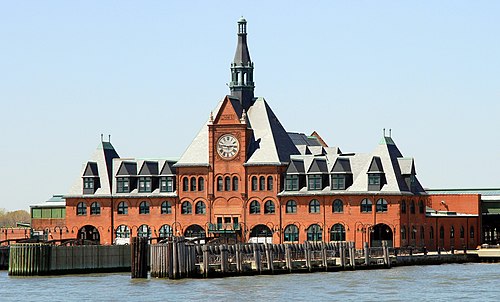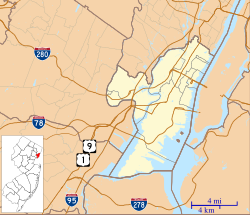Communipaw Terminal | |||||||||||||||||||||||||||||||||||||||||||||||||||||||
|---|---|---|---|---|---|---|---|---|---|---|---|---|---|---|---|---|---|---|---|---|---|---|---|---|---|---|---|---|---|---|---|---|---|---|---|---|---|---|---|---|---|---|---|---|---|---|---|---|---|---|---|---|---|---|---|
 The Central Railroad of New Jersey Terminal at Liberty State Park in 2013 | |||||||||||||||||||||||||||||||||||||||||||||||||||||||
| General information | |||||||||||||||||||||||||||||||||||||||||||||||||||||||
| Location | Liberty State Park Jersey City, New Jersey, U.S. | ||||||||||||||||||||||||||||||||||||||||||||||||||||||
| Construction | |||||||||||||||||||||||||||||||||||||||||||||||||||||||
| Accessible | No | ||||||||||||||||||||||||||||||||||||||||||||||||||||||
| History | |||||||||||||||||||||||||||||||||||||||||||||||||||||||
| Closed | April 30, 1967 | ||||||||||||||||||||||||||||||||||||||||||||||||||||||
| Electrified | No | ||||||||||||||||||||||||||||||||||||||||||||||||||||||
| Former services | |||||||||||||||||||||||||||||||||||||||||||||||||||||||
| |||||||||||||||||||||||||||||||||||||||||||||||||||||||
Central Railroad of New Jersey Terminal | |||||||||||||||||||||||||||||||||||||||||||||||||||||||
| Location | Liberty State Park Jersey City, New Jersey | ||||||||||||||||||||||||||||||||||||||||||||||||||||||
| Coordinates | 40°42′26″N74°2′7″W / 40.70722°N 74.03528°W | ||||||||||||||||||||||||||||||||||||||||||||||||||||||
| Area | 63 acres (25 ha) | ||||||||||||||||||||||||||||||||||||||||||||||||||||||
| Built | 1889 | ||||||||||||||||||||||||||||||||||||||||||||||||||||||
| Architect | William H. Peddle, Peabody & Stearns | ||||||||||||||||||||||||||||||||||||||||||||||||||||||
| Architectural style | Richardsonian Romanesque | ||||||||||||||||||||||||||||||||||||||||||||||||||||||
| NRHP reference No. | 75001138 [1] | ||||||||||||||||||||||||||||||||||||||||||||||||||||||
| NJRHP No. | 1513 [2] | ||||||||||||||||||||||||||||||||||||||||||||||||||||||
| Significant dates | |||||||||||||||||||||||||||||||||||||||||||||||||||||||
| Added to NRHP | September 12, 1975 | ||||||||||||||||||||||||||||||||||||||||||||||||||||||
| Designated NJRHP | August 27, 1975 | ||||||||||||||||||||||||||||||||||||||||||||||||||||||
| |||||||||||||||||||||||||||||||||||||||||||||||||||||||
The Central Railroad of New Jersey Terminal, also known as Communipaw Terminal and Jersey City Terminal, was the Central Railroad of New Jersey's waterfront passenger terminal in Jersey City, New Jersey. The terminal was built in 1889, replacing an earlier one that had been in use since 1864. It operated until April 30, 1967. [3]
Contents
- Description
- Service
- Trackage
- Ferries and ships
- Railroad lines
- Named passenger trains
- Post-railroad service uses
- Gallery
- See also
- References
- External links
It also serviced the Central Railroad of New Jersey-operated Reading Railroad, the Baltimore and Ohio Railroad, and the Lehigh Valley Railroad during various periods in its 78 years of operation. [4]
The terminal was one of five passenger railroad terminals that lined the Hudson Waterfront during the 19th and 20th centuries, the others being Weehawken, Hoboken, Pavonia and Exchange Place, with Hoboken being the only station that is still in use, as of 2024.
The headhouse was renovated and incorporated into Liberty State Park. The station has been listed on the New Jersey Register of Historic Places [5] and National Register of Historic Places since September 12, 1975. [6] It also has been named a New Jersey State Historic Site.





















